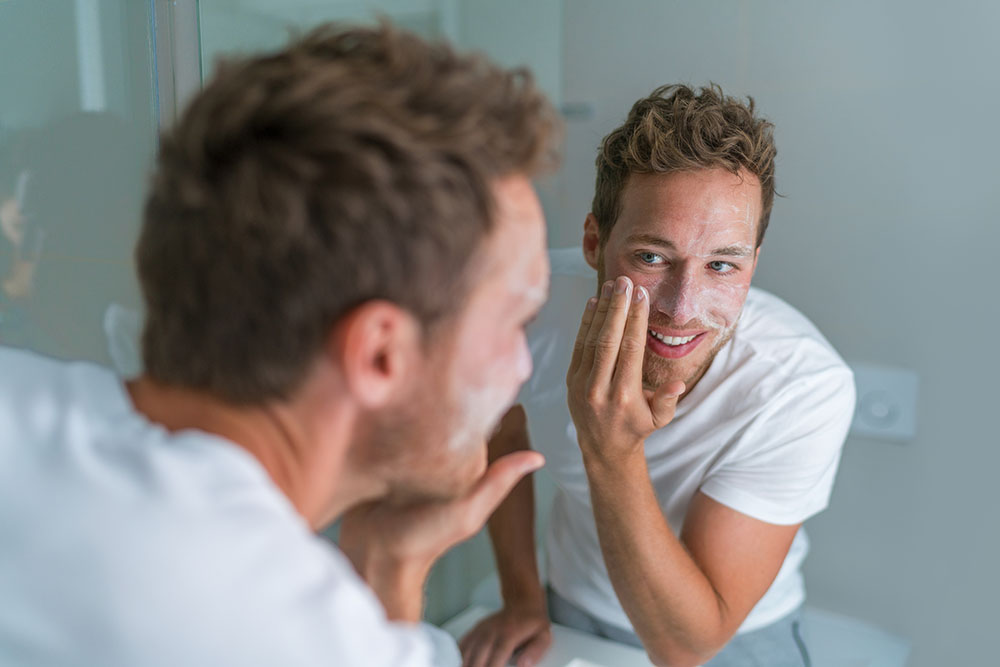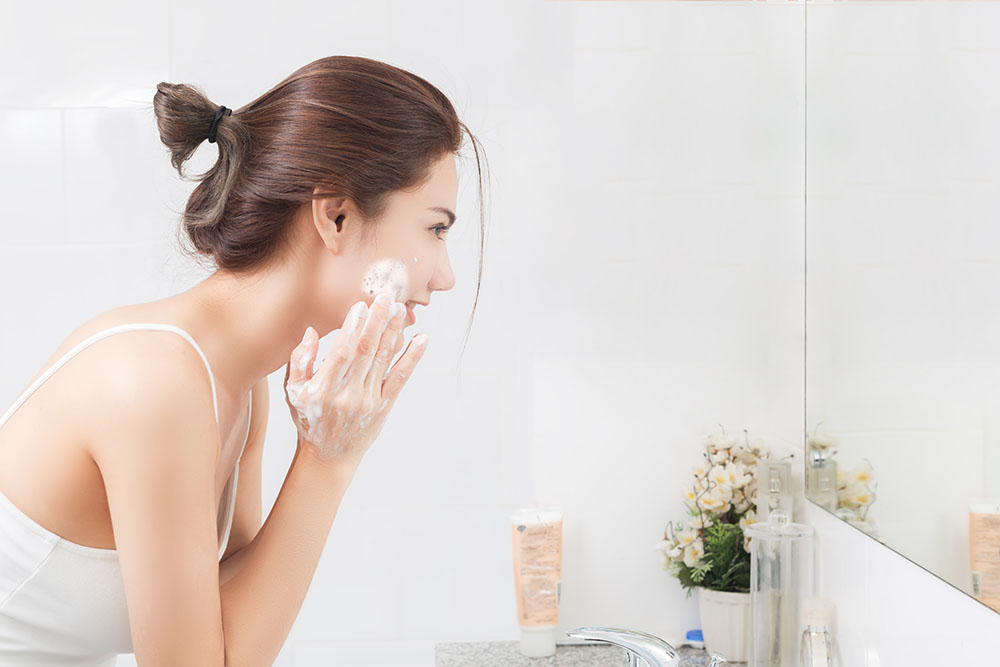Why Cleansing Your Skin Is Essential

Often my new clients will ask if it is essential to cleanse their skin twice a day, and of course I reply yes, with valid explanations of its benefits to the skin. Here are the reasons why it is essential to include cleansing into your skin care regime.
Cleansing your face twice a day in the morning and the evening is an essential step in your daily skin care routine. But with our busy lifestyles it is often rushed or even missed altogether, with the view that it is not that important.
It most definitely is important. Because if this routine is overlooked, excess dirt, impurities, oils, and bacteria encountered during the day start to build up on the surface of the skin and in the pores. This can lead to a build-up of congestion, which causes acne symptoms such as blackheads, whiteheads, pimples, and milia. Daily pollutants and chemicals accumulate on the skin’s surface, which cause free radical cellular damage on the skin and lead to inflammation symptoms such as eczema, dryness, skin redness and premature aging.
Cleansing the skin will prepare it for affective absorption of the active ingredients in products that are applied thereafter.
It makes sense to most people to cleanse the skin in the evening, as this will remove the excess oils, daily pollutants, and make-up you’ve accumulated during the day. It will also prepare the skin for the application of night recovery serums and creams.
Often people think it is not important to cleanse the skin in the morning, as they believe that they are not accumulating dirt etc whilst sleeping. The fact is we do produce oils and cell debris whether awake or asleep, and these need to be removed with a cleansing procedure. Cleansing will refresh and revive the face in the morning. It will prepare the skin for protection against daily stresses, such as bacteria, pollutants and photoprotections UVA, UVB, HEV, IR, via the use of Serums, Moisturisers, Gels and SPF products.
Your home skin care routine should take no longer than the time it takes to brush our teeth, so give it go and achieve a clearer, healthier and brighter skin.
The Types of Cleansers
There are endless types of cleansers available on the market and finding the best to suit your skin can be overwhelming.
As a general rule, use a cleanser that is the PH balance of your skin, 4.5 to 5.5 acid balanced. A cleanser that is not within these parameters can disturb the surface of the skin, the NMF (Natural Moisture Factor), the protective barrier which is composed of natural oils and moisture. The consequences of stripping the NMF can lead to the sebaceous glands producing more oil than necessary in an attempt to re-build the NMF, whilst moisture escapes leaving the skin oily but at the same time dehydrated.
Cleansers that contain active ingredients such as AHA’s (Alpha Hydroxy Acids), excellent ingredients to promote cell renewal, or BHA’s (Beta Hydroxy Acid), excellent acid to break through excess sebaceous oils, can also alter the PH of the skin. However, it greatly varies depending on the other ingredients in the cleansing product.
Applying hydrating and moisturising products is essential after cleansing your skin, especially when the use of some cleansers that can potentially cause this PH disturbance.
Use a water-soluble cleanser. Cleansers that are not water soluble would require either alcohol or an alternative astringent tonic product, or very hot water to break through the ingredients that are not water soluble. Astringent ingredients can alter the PH of the skin, and the consequences of this have been described above. The very hot water option can cause redness, irritation, and even lead to permanent dilated capillaries in prolonged use. Failing to remove the cleanser thoroughly simply leaves it mixed in with the dirt, pollutants, and make-up, which remain on the skin surface.
To avoid skin irritation do not use a cleanser containing perfumes or fragrances, unless sourced from a natural botanical or an essential oil
Typical Types Of Cleansers
- Foam Cleansers
- Gel Cleansers
- Oil-based Cleansers
- Micellar Water
- Cleansing Balm
- Cleansing Bar
It is important to recognise that all of the listed cleansers can be blended in a complex formulation of ingredients, which means that each type of cleanser can be suited to a particular skin type providing the ingredients meet the criteria of the skin type.
It is important to use the correct cleanser for your particular skin condition. Using the wrong cleansing product or procedure can be detrimental to the health and condition of your skin.
Always seek advice from an experienced skin care specialist.
A Word on Water
Another important factor is how hard the water is from your tap. Hard water has a high alkalinity, which means it can raise the skin’s surface pH and disturbs the NMF as described above.
If you do have hard water at home then ideally use distilled, or purified water, or even invest in a water softener. This would be beneficial for your skin, as well as for your hair; even your taps and pipes.
Other options would be to use alternative types of water such as organic rose, chamomile, or lavender water.
Read More On The Blog:
‘A Word on Water.
How It Affects The skin’
Cleansing Procedure
Ideally use a cleanser recommended for your skin by a skin care expert who has completed a skin analysis and consultation to ascertain your skin condition.
Always cleanse twice am and pm, as the first cleansing removes any dirt or debris and the second is actually cleansing your skin.
Limit cleansing to twice a day unless you are an active person and perspire after exercise, then it would be a good addition.

- Wet your face with lukewarm water, then with your fingertips apply the cleanser according to its specific application guidelines.
- Use gentle circular motions to disperse the cleanser over the entire area of the face and neck.
- Cleanse the skin with this motion from between 30 seconds to two minutes for optimal cleaning.
- Splash off the cleanser thoroughly with lukewarm water, or wipe clean with the water option of your choice, following the specific removal guidelines.
- A clean, soft, washcloth, mesh or sponge can be used if preferred. However, take care that they do not irritate your skin.
- Rinse off the cleanser thoroughly, especially down the sides of the face by the hair line and ears, to avoid an accumulation of cleanser, or dirt, etc being dispersed and left here.
- Use a light pressure at all times.
- Do not rub the skin to avoid irritation.
- Gently pat the skin dry with a soft clean towel.
- After cleansing, the skin should feel fresh and soft, but not tight.
NOW REPEAT STEPS 1 TO 10
Remember, always cleanse twice am and pm, as the first cleansing removes any dirt or debris and the second is actually cleansing your skin.
Now the skin is prepared for further products to exfoliate, treat a specific condition such as pigmentation, hydrate, promote anti-oxidant support, or moisturise and SPF
Cleansing Products I Trust & Recommend
Dermalogica & Mesoestetic
Keep your skin clean…
keep your skin healthy…
Viridian Skin & Health Supplements are available at:
Emporium Treatment Clinic.
Visit our SHOP here.
Useful Reads
The Clear Skin Cookbook – The Medicinal Chef Dale Pinnock
Fuel Food Cookbook – Oliver McCabe
Author: Angela Taffinder the founder of Emporium Treatment Clinic. A practising Aesthetician for 35+ years, holistic and wellbeing advocate and yoga instructor.
Skin Care & Body Analysis & Consultation
Available at Emporium Treatment Clinic provided by Angela Taffinder the founder of Emporium Treatment Clinic and practising Aesthetician for 35+ years
Contact Us here
Health & Wellness Analysis & Consultation
Available at Emporium Treatment Clinic provided by highly qualified, experienced Doctors, Nutritionist, Holistic Medicine practitioners and Wellness experts.
Contact Us here
